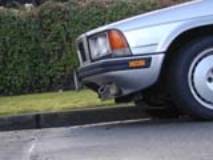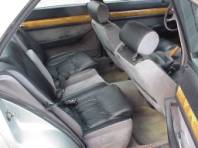The 228
According to the Maserati USA press release issued to announce the arrival of the 228 in the US, the 228 was 'handcrafted at the legendary Milan design studio Zagato'.
The 228 was Maserati's attempt to take their Biturbo products upmarket and compete with Mercedes and the higher end BMWs. Specifically the BMW 635CSI, the Mercedes 300CE, the Jaguar XJ-S and the Cadillac Allante (really!). It was imported into Canada the US in 1989 and 1990 with the 3 valve 2.8 litre fuel injected engine, although it was available in other parts of the world as early as 1996 in carbureted form. A few 1991 models snuck into Canada. Less than 100 were brought into the US (and Canada, each or total I am not sure) during these 3 years. I read somewhere that Canada received about half of what came to North America (I think that was just for one year only). The UK got just over 20. Apparently 10 1990's were brought into Canada and all were automatics. 120 '89s were planned for the US, how many actually made it I don't know. I heard from another 228 owner in Europe that a total of 469 228s were built between 1988 and 1990.
I understand that imports to Canada were halted in when Lexus complained to the Canadian government about Maserati not meeting the applicable crash standards. (So don't buy a Lexus.) Used 228's are not allowed to be imported into Canada from the US, unless they are 15 years old or older. Which they all are at this point. In the US however, I understand they have to be 25 years old. Anyways, since I already have one, I don't need another!
228 versus the 430
At the time the 228 was sold in Canada and the US, Maserati also sold another hardtop model, the 430, as well as the softop Spyder. Although all are direct descendents of the Biturbo, none carried the Biturbo name. The 430 however is basically a four door Biturbo.
From looking at the 228, the relationship to the 430 and the Biturbo family is fairly obvious. The 228 is larger physically than the 430 in both width and length (4460 mm versus 4400 mm, and 1865 mm versus 1730 mm ), and the interior, though physically larger than a 430, is finished in a slightly better manner than a 430, with lots of real leather and real wood veneer. The 228 weighs 32Kg more than the 430, no surprise given that it is bigger. The engine and mechanicals are the same in the two cars.
There are a couple of specific things that are different between the 228 and the 430, aside from the obvious size difference and related design cues.
When not in use, the wipers on the 228 are hidden behind a lip at the rear of the hood. On the 430 they are clearly visible when not in use. I think this is a nice touch on the 228.
The front end treatments are slightly different too, with
the 228 having additional vents directly below the headlights. These may have
been designed to allow cooler air enter the turbos, but since the air intakes
for the turbos are in fact located above and behind the lights, I don't really
think these have much effect, although they may lower the temperature of the
engine compartment. The turn signals wrap around the front of the car, much like
an older BMW 6 series, and the 228's grill is a bit different than the 430's.
These two photos illustrate the front end treatments on the 228.
The rear on the 228 is a bit more rounded, and is less stubby than a 430.
The 228 is a two door, and the 430 a four door, so the doors on the 228 are much larger than the 430's doors.
The 228 came with slightly different rims than a 430, and slightly fatter tires on the rear.
Here are a some shots of a 430 that was for sale some time ago at Forza. The 430 interior is not as nicely done as the 228 either. In particular, the only alacantra (fake suede) in the 228 is the ceiling liner, the upper part of the door panel, and the 3 pads on top of the dashboard on the passenger side. The 430 seems to have quite a bit more alacantra in it. Another more subtle difference is that in the 228, the alacantra on the door is 'curtained', giving it a fancier look. (You can view the 228 interior on my interior page.)
|
|
|
|
I heard from a guy who owns a 228 and who previously owned a 430 that the 430 would blow the doors off the 228 as far as handling goes. I am inclined to believe him, as the 228's handling is definitely a weak point.
Differences Between 228's
All 1989 228s brought into Canada and the US were 5 speed. All 1990 228s brought in were automatic. The 228 was not brought in for any other years. There are no differences in the cars between 1989 and 1990. However, there seem to be some minor differences in the cars as they evolved on the production line.
The Maserati Manual on Page 0-41 refers to a 1st Series and 2nd Series version of the 228 (and also of the 430). The primary difference seems to relate to the turning radius of the cars. I also recall when I was doing some of the initial planning on the suspension changes, that measurements had to be made of the car's original suspension in order to ensure the shop knew what kind of 228 I have. I have no idea what other differences may exist between the two series, or if there was a S/N cutoff for them.
My car has a plate installed in the engine compartment on the passenger side, just above the gasket that seals the engine compartment off when the hood is closed. In other words, the plate is somewhat exposed to the elements even though it is under the top part of the hood. When you stand by the passenger side mirror and look down the windshield, past the wiper, and under the hood, you can see it. You can also see it if you just open up the hood and look at the top left. I have observed a 228 that was only a couple months older than mine without this plate. It provides some information on recommended lubricants to use in the car.
I have observed differences in exterior trim between 228s. Initially I thought that the cars came from the factory with pinstriping and trim all the way around, and any car that differed had been repainted. After talking to a number of people who were involved with Maserati when these cars were being imported, I have developed the opinion that this trim was dealer applied. That's why it is not consistent between cars.
I have also observed differences in the colour of the exterior mirrors on 228s. Some are painted the body colour, while others are painted a flat black that matches the colour of the rocker panels and some of the window trim. I am quite certain that all cars came from the factory with their mirrors painted black. So any car that has coloured mirrors is not original, and the repaint likely happened at the time that some or all of the rest of the car was painted!
There are also differences in the dashboard. My dash is solid black leather, except for a tray area ahead of the passenger. Others have a part leather part velour dash, with the instrument pod hump and a larger area in front of the passenge in velour.
Impressions
The car drives well, but it is not a sports car out of the box. The '87 Lotus Esprit Turbo HCI that I previously owned offered better acceleration, way better handling, plus more 'eyeball' than the 228. They both cost about the same to maintain, the 228 perhaps a bit more, although the 228 was cheaper up front. The 228 has four seats though!
The stock 228 has a nice surge of power in the middle/upper portion of the RPM range, though unless you rev the heck out of the engine then pop the clutch, you will not be taking any 5 litre Mustangs or hopped up Hondas off the line, without some work having been done on the engine. You'll have no trouble with any highway on ramp situation though. The car is a bit lacking in low range torque. Increasing the boost made a big difference, although only when the turbos are spooled up. I still highly recommend adjusting the boost.
The handling is a disappointment though. The new tires helped, but the car really needs an anti sway bar in the rear. I drove a new Subaru Outback recently and found that it handles better than the stock 228. The steering is not tight at all, it feels vague and truck-like to me. I was not confident at all in keeping my foot in it around tight turns. This is the area of the car that is most lacking and that needs the most work. The car is also fairly low at the front and I have to be excessively cautious on any speed bumps. Lowering the car made this situation even worse. I am now ultra slow going over speed bumps, much to the annoyance of whoever is behind me I am sure.
The interior of the 228 is one of the best looking interiors I have ever seen though. It is way better than any Japanese or German car I have ever seen, only the luxury Benz's like the S500 rival it. The quality of the fit and finish is excellent, and everything (yes - everything!) works. The heater works like a charm, although the windows do tend to get fogged up pretty quick when it's raining out, especially if my clothes are damp from the rain.
Given the small number of these that are around, it is a pretty unusual car. Most people who know a little bit about Maserati and may have heard of the Biturbo are generally unaware of the 228. The car rarely gets a second glance around town.
So I think it is a rare car with an excellent interior that, with a little work on the engine and a little more work on the suspension is a great car.
Here are some shots that I took with the Ghibli Cup wheels on the car, but before I had the car lowered.










